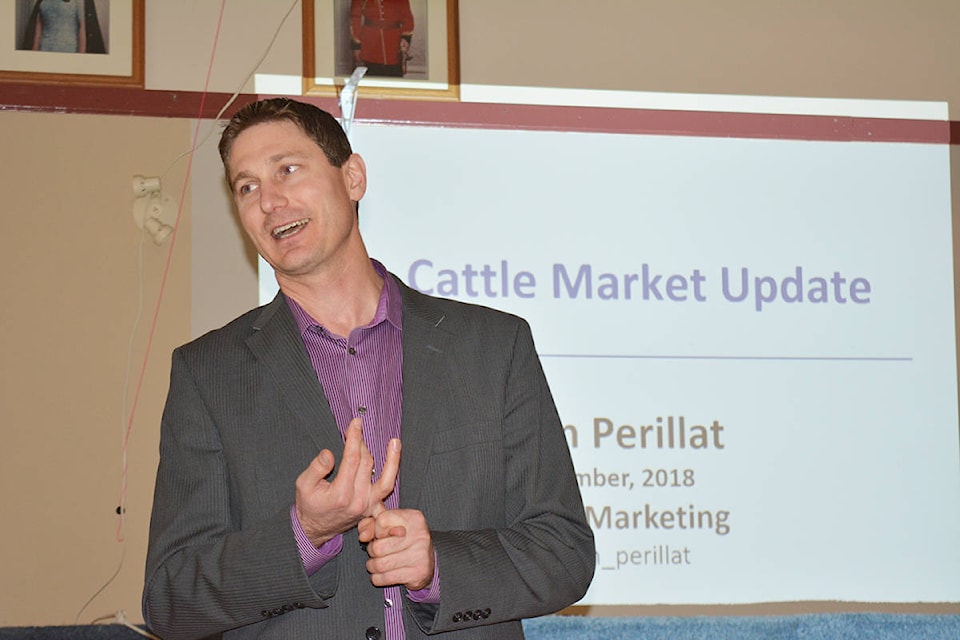Lindsay Chung
Observer Contributor
There are so many factors that affect the cattle markets, and local cow-calf producers heard some of the good news and bad news last week.
Brian Perillat, the manager and a senior analyst at Canfax Marketing, based in Calgary, provided an update on the cattle market during a Farm Credit Canada knowledge exchange event Nov. 21 at the Royal Canadian Legion. “Disruptive Ideas That Drive Innovation and Trends and Trade Opportunities in Beef Markets” also included a presentation by Kevin Stewart about setting your operation up for innovation.
READ MORE: How do you put yourself in a position to innovate on your farm or in your business?
According to Perillat, global beef production is picking up, and he sees opportunities there for North American beef producers.
“Realistically, we have a lot more people in the world to feed,” he says. “We’re going to have the growing population, but I do like to bring people back and say just because we have more people to feed doesn’t guarantee higher prices. It really comes down to wealth. Can more people afford to consume more beef? And that’s where things aren’t moving. Developing countries, the Middle East, North Africa, Asia’s a big one … they’re talking about 300 million people moving into the middle class in the last five years, 2015 to 2020, and those are the people who are going to start consuming more beef. They want a Western diet.”
According to Perillat, global pork and poultry production has consistently been growing over the last five years, while beef production didn’t change a lot from 2010 to 2015, though it has been growing more recently.
“There was good demand globally in 2014, 2015, 2016; tighter beef supply and we saw beef prices shoot up globally,” he says. “As a result of that, the last two to three years, we’ve seen beef production increase. The U.S., North America, we’re looking at record beef supplies. Our prices are still pretty darn good, mostly due to the global strength.”
Perillat believes a positive for North American beef producers is that China is not growing its beef supply very much and is looking to import.
“China, South Korea, Vietnam – all those countries are growing pretty fast on beef imports, and that’s where we’re well-positioned,” he says. “And, really, we’re going to need that when we talk about how much beef we’re starting to produce here. We need export markets.”
Perillat says Canada does have some open trade with China and is in a good position because China requires that beef comes from countries that have a full traceability system, which Canada has. The U.S. does not have a national program, so a lot of U.S. beef doesn’t qualify.
“Looking at China overall, five years ago, China was just stepping onto the world scene; they were barely in the Top 10 of global importers, and right now, they’ve moved up to a very significant No. 2,” says Perillat. “Within a couple of years, China might be the biggest importer of beef.”
The No. 1 beef importer in the world is the United States, according to Perillat.
“They’re the biggest producer and the biggest exporters, but they’re also one of the biggest beef importers in the world,” he says.
Perillat says the U.S. is seeing record large beef production in 2018. The U.S. has been expanding its cow herd, but Perillat says that expansion is pretty much done.
“We have a big calf crop in 2018, and those cows are not going to turn into beef until 2019,” he says. “2019, maybe 2020 will continue to see growing beef production, but it’s going to flatten out, and in my mind, if we continue to see growth on the demand side like we have, that still paints a pretty good picture for cattle. These supplies are probably going to weigh or limit upside on the market in the next year or two, without a doubt, but there’s still that longer-term opportunity I think for beef producers.”
Perillat says despite record production and growing exports, the U.S. still imports almost as much beef as it exports.
“In Canada, we still export about 45 per cent of our beef,” says Perillat. “Seventy-five per cent of our beef goes to the U.S. I think the most exciting thing about exports from Canada is usually in the export market, whether it’s beef or canola or paper clips, usually if you want to sell more, you have to do it at a lower price. Usually when we produce more, prices go down. In the global marketplace for Canada and the U.S., in the last two years, we’ve exported more beef and we’re doing it at higher prices. That’s the best-case scenario: you sell more and you sell it at higher prices.”
One of the things that concerns Perillat, though, is that this year, feedlots have been losing a bit of money lately.
“Usually, November, December, fed prices pick up, but we haven’t seen it very much. It’s been slow. It still could come here, demand is high, but prices are low. That’s one of my big concerns going into 2019. Basically, if feedlots are going to be losing money, they may want to pay less for calves. Feedlots are full; they’re losing a bit of money. What happens? They’re going to pay less for calves, and that’s sort of what we’re seeing the last couple of weeks.”
